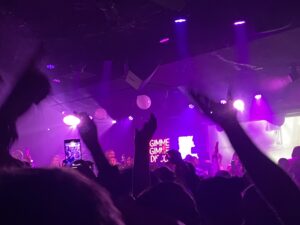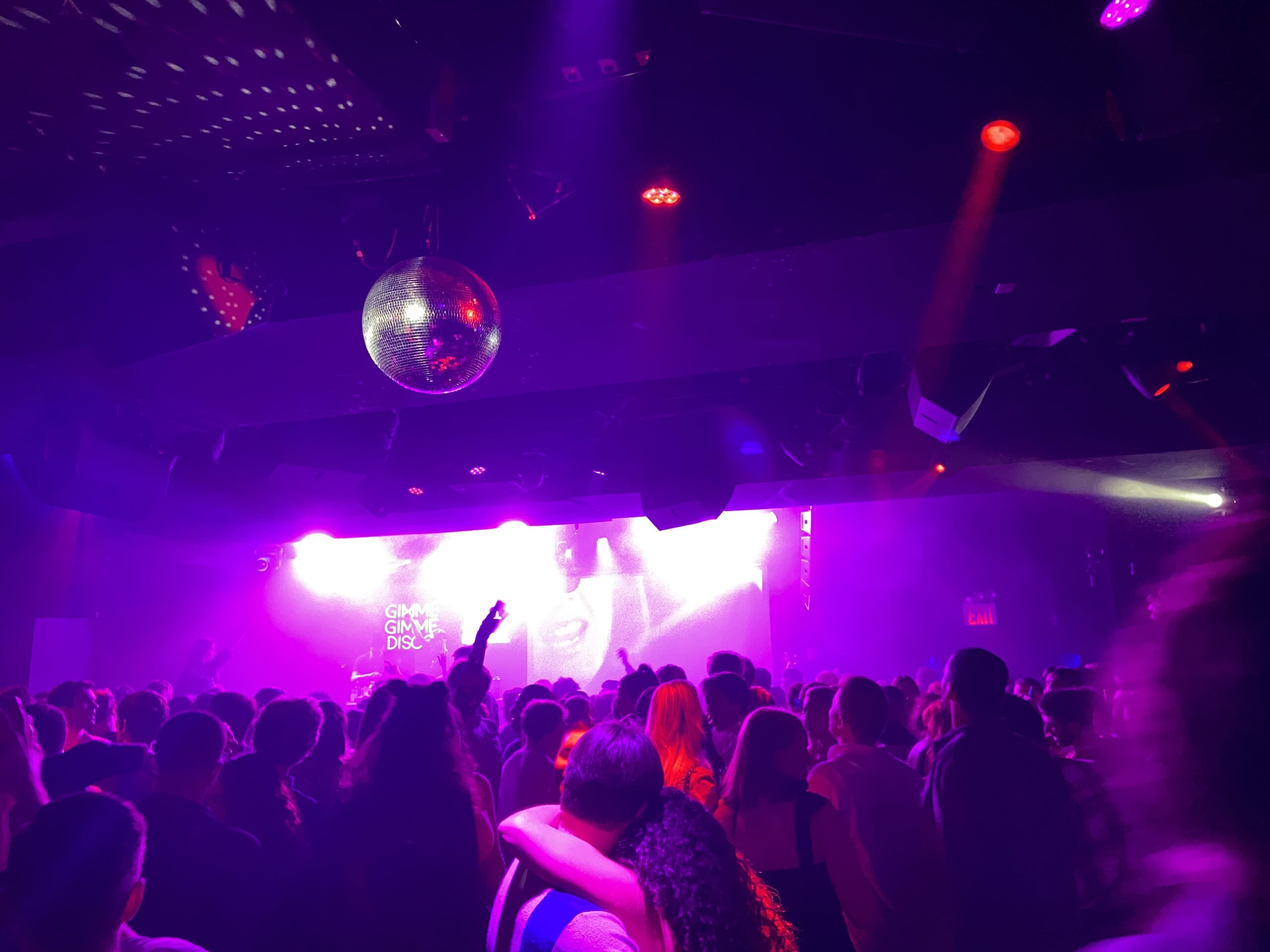Picture this: you’re at a party, a single disco ball hangs from the ceiling, and strobes of blue and purple lights illuminate the dance floor. The DJ’s turntables sit on the elevated stage, above it a neon sign that reads “Follow the call of the disco ball.” The room fills with over 200 people dressed in aluminum mesh material, zig-zag shirts, and chevron-printed pants. The countdown begins, the mood shifts, and people run to the dance floor.
Numbers appear on a projected screen on the stage, and everyone gathers around, counting down,“3…2…1.” ABBA’s “Lay All Your Love on Me” explodes through the speakers. You scream the words, quickly swept into the funk bass and disco synths. The clock has turned back. You’re transported to a different time, the 80s. Did you know you can experience this disco feeling in the year 2023? Gimme Gimme Disco is an 80s- and ABBA-inspired event that hosts dance parties to your favorite 70s and 80s hits. The hosts travel throughout the United States enticing those around to come enjoy a night of nostalgia.
The world has entered a time machine. Fashion, art, and especially music from our past has found its way back into our lives. The melodies of before play in the ears of this newer generation, sometimes in its purest form, other times through a spin on the original. The old saying goes that “music never dies,” but most recently, it’s felt like a complete resurrection with music from various decades trending online. Why have we become so eager to look back?
Kate Bush’s “Running Up That Hill (A Deal with God),” released in 1985, has gone No. 1 on the global charts, 37 years later. Featured in season four of Netflix’s “Stranger Things,” the song gained immense traction across numerous platforms. A music data site reports that the song amassed 1.1 million streams within a week of its debut in the show. Over 2.3 million creations were made with the song on TikTok. Users covered the song and used it in their backgrounds and skits.
But Bush’s song is not the only one to hold the internet captive: the Bee Gees’ “More than a Woman” (1977) created a viral dance challenge when the song was turned into a mashup with rapper Nelly’s early 2000s hit “Hot in Herre.” ABBA, a band who has had multiple viral songs on TikTok, had its song “Angeleyes” (1979) become part of a prevalent trend where users use the sound to reminisce about past shows and snacks from their childhoods.
According to Jason King, Chair of New York University’s Clive Davis Institute and a professor of emerging media and music, there is a name for this phenomenon. “The 21st century has also been defined by what writer Simon Reynolds called ‘retromania’ — a fascination with nostalgia and all things from the past,” King said.
He explains that our online accessibility has powered this retromania. “Social media platforms like YouTube have made all sorts of popular culture products from the past immediately available with the click of a computer,” King continued.
The internet and entertainment media has reinvented the way these songs fit into our society.
What happens when you step offline? The nostalgia does not stop away from your phone screen: many who enjoy the music from decades prior have joined together to create themed dance parties and sing-alongs. You can find this type of event in all genres — but disco reigns supreme.

Essence Case, 28, is a prime example: she traveled from Philadelphia to attend the aforementioned Gimme Gimme Disco, one of their New York events. “I live in Philly, but she wasn’t coming down,” Case said, pointing to a friend, “so we found this one on the website.”
Case is a Mamma Mia superfan, so attending events like these fuels her love for the movie and ABBA. She, however, was not influenced by the recent TikTok trends. “[TikTok] actually turned me away. I feel like it’s taken away from the originality,” she expressed.
Newer music, she said, has less substance. “It’s all about the same thing, money and girls and stuff like that,” she said. “And you never really find an artist nowadays that really talks about the true meaning [behind] whatever else they’re singing about. It’s sad, really sad.”
An article in The Atlantic titled “Is Old Music Killing New Music?” states that over 70 percent of the U.S. music market is now filled with old music. Citing the recent plunge in Grammy’s TV viewership as a key sign of new music decline, the article makes the case that it is not the lack of new music that is causing the decline, but also what is being done elsewhere in the industry, like major music labels investing in old catalogs rather than nurturing newer musicians.
Jason King agrees with this assessment. While he doesn’t believe the “veteran” artist finding renewed success decades later is a new occurrence, it’s clear labels have begun to prioritize this demographic. “Record labels are heavily focused on the marketing and promotion of their back catalogs — music documentaries, jukebox musicals, etc. — as those catalogs represent less risk than signing, and trying to break, newer artists,” King said.
He emphasizes what this means for this older music now that veteran artists are selling their catalogs. “Classic music, as it changes hands, has the possibility of circulating even more through new marketing and promotional opportunities,” he added.
The Atlantic article has, however, received rebuttals. Another article, from InsideHook, states that the data referred to as “old music” is represented only by music older than 18 months. It claims that perhaps it’s not that older music is being streamed more, but that people are not listening to the top hits any longer.
Jack Peterson, 22, the general manager of NYU’s radio station and host of his own three-hour radio show centered around new music discovery, seems to concur. “You could theoretically run out of old music to listen to,” he expressed, “but you could never run out of new music to listen to, because it comes out all the time. A time will come when we get bored of what already exists.”
Peterson finds that our current technology allows us more freedom to explore a wide variety of music. “People finally have agency to find their own stuff that actually sounds good to them. It’s become easier. I think that people are understanding there is more out there than what their spoon fed on like a top forty radio station,” Peterson said.
Faith Lamacchia, another attendee of the ABBA-themed disco party, has followed her own path of music discovery.
“I grew up on country music, and then living with other people who liked different types of music and hearing it be so famous on the radio, I just became accustomed to it,” she said.
Unlike Case, Lamacchia and her friend have discovered their music through social media, and are all-the-more grateful for it. “Seeing it now, and dancing to it and being so carefree, is so much fun,” Lamacchia said, brightly.
Research by the American Psychological Association about the sociality of nostalgia explores the idea that we as people become more connected through nostalgic social exchanges. “The nostalgiser feels social connectedness, that is, a sense of belongingness and acceptance,” the authors wrote. It may be that ”belongingness” is what the phenomenon boils down to. Those of the new generation banding together and celebrating songs that have brought people together for years.
“At a time in which many contemporary artists and songs seem interchangeable and disposable,” King said, “the public has latched onto artists from the recent past who represent and symbolize permanence and substance.”








